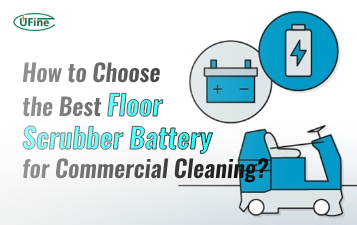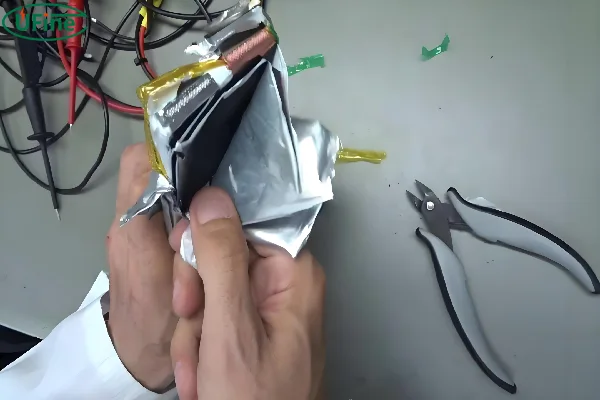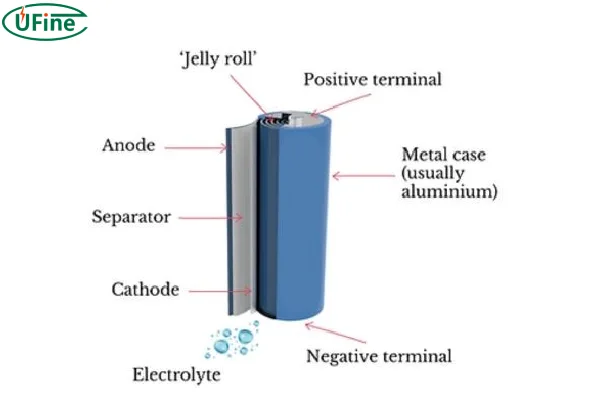Lithium batteries have become an essential power source for all modern devices. You may have seen lithium batteries powering smartphones, laptops, electric vehicles, power tools, etc. But have you ever tried to learn about lithium battery components and their working mechanism? This article will take you inside the battery to introduce all battery components and their functionality. So whenever you see a lithium battery, you will understand its chemistry.
Part 1. What are the types of lithium batteries?
Lithium batteries come in many types due to their different chemistry and battery components. Each battery type has pros and cons that address specific electric needs. However, there are six main types of lithium batteries as follows.
1. Lithium Iron Phosphate
Lithium Iron Phosphate is also known as LiFePO4 or LFP battery. Inside this, battery components like phosphate work as a cathode, and graphite carbon as the anode. Mostly, LFP batteries come in 3.2 nominal voltage, but connecting in series makes it a 12.8 volt battery. Not only are LiFePO4 batteries good with thermal stability, but they also have long life cycles.
2. Lithium Cobalt Oxide
Lithium Cobalt Oxide, or LCO, has high energy density with a lightweight and compact size. In the battery, lithium cobalt oxide ( LiCoO2 ) works as a positive electrode material, and graphite works as a negative. These battery components provide high energy density but some safety and lifespan concerns. Usually, an LCO battery has 500 to 1000 life cycles and is suitable for smartphones, laptops, tablets, and cameras.
3. Lithium Manganese Oxide
A lithium manganese oxide (LMO) battery uses lithium manganese oxide as the cathode and graphite as an anode. These battery components create a 3-D structure that ensures the ions flow smoothly with minimum resistance. Low internal resistance also improves thermal stability and makes the battery safer. It has lower life cycles, between 300 to 700, whereas these are usable in medical instruments, power tools, and some hybrid electric vehicles.
4. Lithium Nickel Manganese Cobalt Oxide
NMC or lithium nickel manganese cobalt oxide battery components are based on nickel, manganese, and cobalt. NMC battery uses each element’s feature to make a reliable battery. For example, nickel and cobalt’s high energy and manganese stability collectively make a stable high-energy battery. So, it can be a good choice for electric vehicles, power tools, and portable devices.
5. Lithium Nickel Cobalt Aluminium Oxide
NCA or lithium nickel cobalt aluminum oxide battery provides a good balance between energy density and power delivery. Moreover, the battery has a long lifespan due to nickel, cobalt, and aluminum battery components. Most of the electric vehicles use these NCA batteries.
6. Lithium Titanate
Lithium titanate or LTO battery replaces the anode’s graphite material with titanate, and the cathode can be made of LMOA or NMC battery components. The LTO battery supports fast charging and can operate at extreme temperatures. Mostly, it can be used in EVs, power stations, and UPS. However, it has a low energy density, which makes it a high-weight battery.
Part 2. What are the components of a lithium cell?
Each lithium cell has some electrochemical components to deliver and store electrical energy. These are anode (-), cathode (+), electrolyte, and separator. All of these battery components are assembled in a battery casing for proper working.
1. Cathode (+)
It is a positive electrode usually made of lithium-containing metal oxide. Cathode material can vary from one battery type to another, such as lithium cobalt oxide (LiCoO2), lithium iron phosphate (LiFePO4), or nickel-manganese-cobalt oxide (NMC). These battery components facilitate and release the lithium ions during the charge and discharge cycle.
2. Anode (-)
The anode is a negative terminal of the battery. Most of the time, it is made from graphite or silicon-based material. During the discharging process, lithium ions migrate from the cathode to the anode and assemble in the crystalline structure.
3. Electrolyte
There are electrolytes inside the lithium battery. It is a lithium salt dissolved in an organic solvent. The purpose of electrolytes is to help lithium ions to move easily between the cathode and anode. These reduce resistance and make sure the battery works for a long time.
4. Separator
The separator is a microporous plastic film between the anode and cathode. It physically locates positive and negative battery components to prevent any short circuit.
Part 3. How are lithium cells made?
Lithium cell making involves many essential steps, from electrode preparation to final testing. Each step of lithium cell making involves equal attention and protocols.
Step 1: Electrode Preparation
Electrodes are the positive and negative battery components made using lithium, cobalt oxide, and graphite. The electrode can be different depending on the battery chemistry. In the process, electrodes are synthesized and combined with conductive additives and binders to create slurries. Then, slurries are coated onto thin metal foil current collectors (aluminum for positive, copper for negative) and then dried.
Step 2: Electrode Cutting and Stacking
In the next step, the machines cut the electrode sheets according to the precise shape and size of the lithium cell. After cutting, they stacked the positive and negative layers with separators between them. All the battery components are stacked carefully to avoid short circuits and leakage.
Step 3: Electrolyte Filling
In this step, the battery components of electrodes and separators are stacked into a battery case. Then, the liquid electrolyte solution, consisting of a lithium salt dissolved in organic solvents, is carefully injected to saturate the porous electrodes and separator.
Step 4: Sealing
Once the manufacturers stack all the battery components inside the cell casing, now it’s time to seal them properly. They coat the laminated film around the cell and heat all-round edges for proper sealing.
Step 5: Formation Cycling and Testing
In the final step, the cell undergoes initial charging and discharging procedures to form and establish a stable solid electrolyte interphase ( SEI). This process helps to activate the cell by ensuring the proper working of its battery components. Moreover, the cell goes under rigorous testing and inspection phase to ensure all the metrics like power, capacity, safety, and cycle life.
Part 4. How to assemble a lithium battery pack?
Now, it’s time to understand how each cell assembles a battery pack. A single battery pack may contain many individual cells.
Firstly, the manufacturer assembles the cells into a rack and wields each cell to the other from both the anode and cathode. The quantity of cells depends upon the AH required. For example, a 50Ah battery will need 15 cells.
After the welding and binding procedure, the manufacturer installs a battery management system BMS that ensures the proper working of all battery components.
In the final step, they test the battery and analyze different battery matrices, as they had done with each lithium cell. When a battery completes all testing procedures and battery components functionality, it gets a green signal and sends it into the market.
Part 5. Lithium battery safety test
Every lithium battery needs to pass the safety tests. It ensures the battery safety and smooth functionality of all battery components. The battery’s BMS plays a critical role in passing the final test. If the BMS detects the situation very well, most of the time, the battery passes the test.
Some of the key battery tests are the following
- Overcharge test
- Over discharge test
- Short circuit test
- Mechanical abuse test
- Fire exposure test
- Thermal abuse test
- Shock and vibration test
The manufacturers conduct battery safety tests according to the procedures and protocol defined by UL, IEC, and UN38.3. At the same time, the result defines the battery’s ability to perform in its intended applications.
Part 6. FAQs
-
What are the main battery components that make up a lithium battery pack?
The primary battery components in a lithium battery pack are the individual lithium-ion or lithium-polymer cells, the battery management system (BMS), cell interconnects, the thermal management system, and the pack enclosure. -
What is the difference between lithium-ion and lithium-polymer batteries?
The difference between both batteries is the electrolyte. A lithium battery uses liquid electrolytes, while a lithium polymer battery uses gel-based polymer electrolytes. From a safety perspective, a lithium polymer battery is a more safe and stable battery chemistry. -
Can lithium batteries be overcharged or overheated?
Yes, lithium batteries can be overcharged or overheated. Usually, it happens when BMS does not function properly or when charging with an improver charger. Overcharging and overheating can cause damage to the battery and lead to an explosion. -
What is the purpose of the separator material in a lithium-ion cell?
The separator is a thin, porous membrane that works as a safety barrier between the cathode and anode. It is one of the important battery components that prevents short circuits and ensures overall battery safety. -
How does BMS monitor and control the lithium battery pack?
BMS performs multiple tasks in the battery pack. It makes sure all battery components work properly. A BMS balances each cell, properly charges, monitors temperature, and prevents overcharge and over-discharge.
Related Tags:
More Articles

How to Choose the Best Floor Scrubber Battery for Commercial Cleaning?
Selecting the ideal floor scrubber battery ensures a long runtime, rapid charging, and minimal maintenance for efficient commercial cleaning operations.
Battery for Blower vs Battery for Leaf Vacuum: Which One Should You Choose?
Battery for blower vs leaf vacuum—learn the key differences in power, fit, and runtime to choose the right battery for your outdoor tool needs.
How to Choose the Right Battery for Blower?
Choosing the right blower battery? Consider voltage, capacity, chemistry & usage. This guide helps match the best battery for peak performance.
How to Choose the Best Insulated Battery Box for Lithium Batteries?
Choosing the Best Insulated Battery Box for Lithium Batteries? Discover key factors such as size, material, and safety for optimal protection and performance.
7 Critical Elements on a Lithium Battery Shipping Label
What must be on a lithium battery shipping label? Learn 7 key elements to ensure safety, legal compliance, and correct handling across all transport modes.






